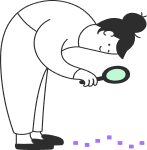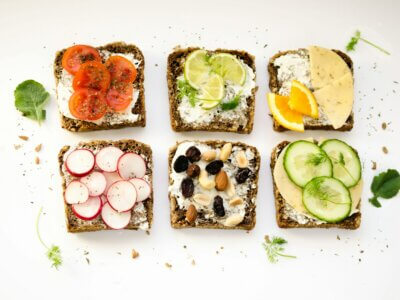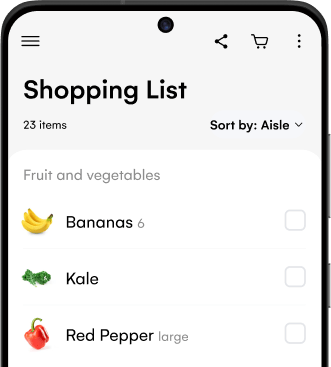At one time or another, you’ve undoubtedly heard that you should eat more fiber. And it’s true. Fiber is an important part of a healthy diet—so important that dietary fiber is considered to be a nutrient of public health concern in the U.S. Most of us simply aren’t getting enough fiber on a daily basis.
Analyse nutritional information for any recipe

On average, the majority of Americans only consume 15 grams of fiber per day—much lower than the daily recommended 22-34 grams. According to the 2020-2025 Dietary Guidelines for Americans, over 90 percent of women and 97 percent of men don’t meet the recommended intake for dietary fiber. But why is fiber so essential, and how can you ensure you’re getting enough of it? Let’s take a closer look at this vitally important nutrient.
What is fiber?
Fiber, also referred to as dietary fiber, is a carbohydrate that your body is unable to digest or break down. Other carbohydrates, unlike fiber, are broken down by your body into sugar molecules called glucose—your body’s main source of energy. Because the body doesn’t digest fiber, it passes through the body and digestive system relatively intact. Although it goes undigested, fiber is an important element of a healthy diet. It helps maintain a healthy digestive tract, prevent constipation, and promote regularity, among other benefits.

The different types of fiber
There are two different types of fiber: soluble fiber and insoluble fiber. Although different, both are beneficial for your health.
- Soluble fiber: This type of fiber dissolves in water and becomes a gel-like substance. Soluble fiber helps lower blood cholesterol and glucose levels.
- Insoluble fiber: This type of fiber, on the other hand, does not dissolve in water. Instead, it retains its shape—adding bulk to your stool and helping food move through your digestive system. Because of this, insoluble fiber helps maintain regularity and prevent constipation.
Different types of food may contain soluble fiber, insoluble fiber, or both. Foods that contain soluble fiber include beans, lentils, peas, oatmeal, chia seeds, nuts, apples, blueberries, and citrus fruits. Foods that contain insoluble fiber include whole wheat flour products, quinoa, brown rice, nuts, legumes, kale, cauliflower, and potatoes. This, of course, is not an exhaustive list but a few examples of foods that contain soluble and insoluble fiber.
The health benefits of dietary fiber
Dietary fiber is a critical component of a healthy and well-balanced diet. First and foremost, fiber is essential in supporting a healthy digestive system. It does so by aiding digestion and improving gut health.
A diet high in fiber also:
- Helps manage weight: Foods high in fiber help us feel fuller, helping us eat less and stay full for longer.
- Lowers cholesterol: Fiber helps lower cholesterol by improving digestion, reducing the amount of LDL or “bad” cholesterol.
- Regulates blood sugar: Soluble fiber helps slow the absorption of sugar, helping to control blood sugar levels.
- Prevents constipation: Fiber increases the bulk and softness of your stool making it easier to pass, thereby preventing constipation.
- Increases longevity: High fiber diets may actually help you live longer by reducing the risk of cardiovascular disease and cancer.
How much fiber is recommended?
Generally, adults should be consuming between 22-34 grams of fiber each day to maintain good health. However, these recommendations differ slightly based on gender and age.
For males aged 14-18 and 31-50 years old, the daily recommended fiber intake is 31 grams. For females in these age groups, the recommended amount of daily fiber is 25 grams. And for men and women 19-30 years old, their daily fiber intake should increase to 34 and 28 grams, respectively. Recommendations for men and women 51 years of age and older decrease slightly—28 grams for men and 22 grams for women.
| 14-18 years old | 19-30 years old | 31-50 years old | 51+ years old | |
| Male | 31 | 34 | 31 | 28 |
| Female | 25 | 28 | 25 | 22 |
These recommendations are provided by the 2020-2025 Dietary Guidelines for Americans.
However, we know that many of us aren’t getting an adequate amount of dietary fiber each day. So what can you do to change this? The short answer: add more fiber-rich foods to your diet.

How to add more fiber into your diet
Fortunately, it’s not difficult to up your fiber intake by incorporating a few high-fiber foods into your everyday diet. To do so, understanding which foods are high in dietary fiber will help you make better choices when it comes to upping your intake of fiber.
What foods to include more of in your diet
In general, high-fiber foods include:
- Whole grains
- Fruits and vegetables
- Legumes
- Nuts and seeds
It’s important to choose foods that fall into these categories above processed foods because much of the fiber is lost in the refining process. Processed foods are refined to remove the bran or outer coat of the grain—reducing its overall fiber content. This includes food items including canned fruits and vegetables, white bread, non-whole grain pastas, and white rice, among other processed foods.
Tips for including more fiber into your daily diet:
- When snacking, reach for whole fruits, nuts, or raw vegetables
- Opt for whole grains where possible—swap white rice with whole grains like brown rice, quinoa, or farro and choose whole grain bread and pasta over processed alternatives
- Incorporate high-fiber foods into your meals—add beans into soups and stews, flaxseed or chia seeds into smoothies, parfaits, and oatmeal, and vegetables into stir-fries and casseroles
Making these small changes in your daily diet can lead to big results and a positive impact on your overall digestive health.
Dive into our content and find culinary inspiration

Natural fiber vs. added —what’s the difference?
Aside from the natural fiber found in whole fruits and grains, fiber is also added into many of the packaged foods we find in the grocery store like protein bars and cereal. But what is “added fiber” and is it truly any different than the real thing?
Natural Fiber
Natural fiber, also referred to as intrinsic fiber, are fibers that are naturally found in foods like fruits, vegetables, and whole grains.
Added Fiber
Added fiber, also called functional or isolated fiber, is fiber that is added to food during the manufacturing process to increase its fiber content. Added fibers can be derived naturally from foods that contain fiber or synthetically made in a lab. There are many different types of added fibers, but recently, the FDA has narrowed down the list to seven isolated and synthetic fibers that meet their definition of dietary fiber. These added fibers include:
- Beta-glucan soluble fiber
- Psyllium husk
- Cellulose
- Guar gum
- Pectin
- Locust bean gum
- Hydroxypropylmethylcellulose
Aside from the seven added fibers listed above, the FDA is considering adding additional isolated and synthetic fibers to this approved list. These include cross-linked phosphorylated RS4, glucomannan, and acacia (gum arabic).
When it comes to determining whether or not a food product contains natural or added fibers, you’ll have to look closely at the ingredient list. On nutrition labels, both natural and FDA-approved added fibers are included in the dietary fiber total.
You may be wondering though, is added fiber all that bad for you? It’s a valid question, so let’s explore the answer.

Is added fiber bad for you?
As it turns out, added fiber and naturally occurring fiber both have the same positive effects on your health. However, although added fiber isn’t “bad” for you, it isn’t recommended to rely on added fiber alone to meet your daily fiber needs. Because natural fiber is found in foods like fruits and vegetables—foods that are packed with other beneficial nutrients—relying solely on added fiber means you’ll miss out on the other positive health benefits of these nutrient-rich foods.
So when it comes to getting enough of the good stuff, stick to naturally high-fiber whole foods as your primary source of dietary fiber.
Phew! Now you’re a fountain of knowledge on eating more fiber, you’ll also want to know how you can tell if you’re getting enough. Aside from eating a diet with plenty of whole foods, use the Samsung Food app to track nutritional content of your recipes. If you see you’re not hitting that fiber target, you can even make substitutions to recipe ingredients to see what impact it has on the nutritional information.



